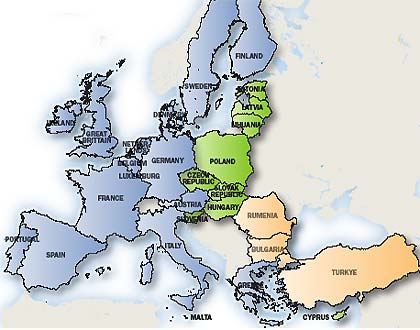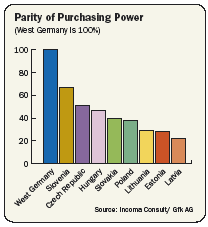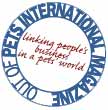Much has changed, a lot more will change.
by: Corine van Winden
In 2004, 10 countries from the former Eastern European region will become members of the EU. The first change in this process is that this area will no longer be referred to as Eastern Europe, but instead as Central Europe. The addition of these new members of the EU will mean that 73.6 million residents will be added to the current 380 million at once, an increase of 20%! However, the Euro will not be introduced as the official currency in these countries until 2008 or later.
This entry also has the necessary consequences for the international pet industry. PETS International spent two weeks traveling through these countries, speaking with many people from the pet industry and has written up its findings in this special report.
Trends
General
In addition to the specific differences found in each country, there is also a great deal of similarities to be found among the various countries. Nearly all of the countries have demonstrated an enormous increase in prosperity in the last several years, and though this may not be on a par with the level found in Western Europe, the gap becomes smaller with each passing year.
As one would expect, the increase in purchasing power has an influence on the development of the retail industry.
Retail
Nearly all of the countries have adopted the French/English concept of retailing, in other words, the construction of large shopping malls at the outskirts of major cities which include shops from nearly all of the well-known western chains such as Tesco, Carrefour, Media Markt and Metro. At present, these centres are already in operation near all of the major cities. The second phase of implementation has already started, namely smaller shopping malls around the smaller cities, yet still with shops from the same, primarily western chains.
See in graphic below for the most important players in these countries.
In comparison with France, for example, it appears that even changes are in store for the retail landscape in Central Europe. For example, the discount channel in France has a 52% share of the market; will Central Europe follow this trend? Or will the shop offering display a greater degree of differentiation?
Within the super and hypermarket channels, the expectation is that the top three will be Carrefour (France), Metro (Germany) and Tesco (UK).
Although the super and hypermarkets also sell pet products, the heavy emphasis within this sector naturally lies on dog and cat good. Depending on the country, 60-70% of these retailers' pet products turnover is accounted for by the dog and cat food segment within which it is primarily their own private labels which are sold as well as Masterfood products. The proportions represented by dry and wet pet foods are primarily determined by the country's level of prosperity.
Additionally, most shops, and definitely the shopping malls, are open seven days per week, and until sometime in the evening. As far as this is concerned, it is not strange that the saying there is "We are already ahead of the Germans!"
As one would expect, there are differences to be found in each country. In Poland, for instance, the concept of a Supermarket involves a huge complex consisting of a "large surface-area" store of one of the above chains with a large quantity of smaller shops or boutiques surrounding it - the so-called gallery. This gallery comprises shops selling a variety of wares: clothing (a great many of these), jewelry, mobile phones, etc. Some galleries even house some 70-80 small shops! It is in these galleries that specialised pet shops are being added – these stores are very upscale and professional and the range of products they offer is larger than that found on the shelves of the supermarket itself.
The economic future of Poland will remain determined by its history. The rich section will be formed mostly by the western area of Poland and Warsaw; this is also often referred to as "Poland A." The eastern half, or that section bordering on Russia, will remain behind the western half, relatively speaking. This section is also referred to as "Poland B."
The pet market
With the increase in prosperity, the expenditures on pets and pet-related products are also on the rise. Fressnapf Hungary witnessed the expenditure per shop visit rise from 11 Euros in January 2003 to 15 Euros by the fall of 2003. However, due to the fact that no true market research is conducted in these countries on any regular basis with respect to the size of the pet industry market, there is no real reliable data which may be provided regarding the size of the pet market in terms of the number of tonnes of food sold nor the number of dogs and cats.
On the basis of information supplied by a number of major players in the industry, there are only indications which may be given such as the following:
| Country | Population Dogs (x mln) | Population Cats (x mln) | Sold Tonnage Dog and Cat food (x 1000 tons) | |
| Dry | Wet | |||
| Poland | 9 | 5 | 60 | 34 |
| Czech Republic | 2,9 | 1,6 | 60 | 35 |
| Slovakia | 0,5 | 0,4 | 25 | 5 |
| Hungary | 2 | 2 | 47 | 51.5 |
| Slovenia | 0,2 | 0,3 | 10 | 5 |
PETS International has observed that there are many pet shops in most of these countries, but that there are only a few shops which could be considered as serious points of sale. Local experts gave an indication of how many of these outlets (pet shops and veterinarian practices) could be considered serious ones.
| Country | Quantity of serious outlets for pet products |
| Poland | 1,500 |
| Czech Republic | 500 |
| Slovakia | 70 |
| Hungary | 1,500 |
| Slovenia | 50 |
| Estonia | 100 |
| Latvia | 200 |
| Lithuania | 150 |
| Cyprus | 30 |
However, outside of these independent shops, there are nearly no pet speciality chain stores present in these countries. There are however all sorts of developments which must be taken seriously. Fressnapf in Hungary has already opened 3 shops in and around Budapest and their goal is to ultimately have 25 shops in Hungary. Naturally they are also looking beyond the Hungarian borders, and have allowed their glance to fall upon the countries with the highest expectations such as the Czech Republic and Slovakia. Expansion to other countries in the long term has not been ruled out.
There are a variety of developments taking place in Poland which also deserve serious attention. After their entrance into the EU, the position of the wholesaler in these countries will be subjected to pressure, and as a result, a number of wholesalers are giving their future some serious consideration. Tuptus in Poland is now a medium-sized wholesaler which is hard at work developing a franchise concept for a chain of pet speciality shops, in addition to its existing wholesale business. The first three shops have already been opened and the plan is for 20 to 30 shops to be open in Poland by the end of 2004.
In Slovenia, the smallest yet one of the richest of the newly entering countries, Hobby Program has been successful for years as a wholesaler and now also as a chain of pet speciality shops. The shops in the chain are highly professional and modern. Hobby Program is also obviously hard at work to launch this formula, based on the franchising concept, in neighbouring countries as well.
But also in Poland a shop such as Market Zoologiczny, modern and extremely professional can definitely handle the competition provided by a chain such as Fressnapf.
Placek (Czech Republic) is also a company that realises that its current role as distributor will start to shift to more of that of a logistics centre and is therefore also contemplating its future role in the market.
Naturally everyone here in the pet industry also expects that Fressnapf will quickly expand to the Czech Republic.
The largest wholesaler in Hungary, Alphavet, is presently working on optimising its logistics system, selling pet products through a call centre, and optimising its Internet and postal order sales, with the objective of becoming the specialised pet products supplier and a match for Tesco and Fressnapf.
An obviously important issue involves the pricing levels and margins at which the products would be able to find their way to the consumer in the various countries. PETS International conducted research for you on this very topic, and the results were as follows:
What does entrance into the EU bring along with it?
Entrance into the EU seems to be a mere technicality, certainly since the populations of all of the new member countries have expressed their preference for EU membership. However, the effects of entry into the EU and the effects on the national pet industries are experienced on completely different levels.
To get more insight into these issues, PETS International asked nearly every player in the local pet industries how they see their industry five years from now. The impressions below were the result.
A reduction in the import and export costs as a result of the elimination of waiting periods at the borders as well as the removal of import duties for primarily non-European products. Particularly with respect to imports from Asia and North America, this is an extremely important factor as in many cases, the import taxes will drop by some 30%. This will mean additional competition for the European manufacturers and distributors.
But who exactly will beneefit from these reductions in costs? The answer is the wholesaler or the consumer who will pay lower prices.
Or will the local wholesaler be forced to lower its prices in order to keep competition from wholesalers such as Gimborn, Trixie, Karlie, etc. at bay? It is after all true that a full range of possibilities will now be available to these distributors. An increase in competition will also arise due to the fact that manufacturers, such as Ferplast for example, will now be capable of supplying the larger (pet) retail chain customers directly. There are also possibilities for bulk export and local packaging activities. In short, the pet market will experience a great deal of movement and shifts which will make it particularly difficult for the smaller distributors.
Average % Margin on pet products for the retailer
| Country | Retail | |
| Premium pet food | Supplies | |
| Poland | 30-40 | 40-50 |
| Czech Republic | 30 | 35 |
| Slovakia | 30 | 40-60 |
| Hungary | 30 | 50-100 |
| Slovenia | 30 | 55 |
| Estonia | 25-35 | 40-60 |
| Latvia | 25-40 | 30-45 |
| Lithuania | 25-40 | 35 |
For the local manufacturers, it will become considerably easier to export to the other EU countries. Producers such as Aquael, Tropical, Hobby P.W., etc. are also currently at work spreading their wings. Due to the fact that their labour costs are still relatively low, they can definitely offer good quality for highly competitive prices when compared with many of their competitors.
In most countries, the consumers are still very loyal to the well-known top brands. These brands represent good quality, promote personal status, etc. But because these countries will also rise to a comparable level, not only will salaries rise, but prices will climb along with them. The expectation is also that the market share of the Private Label products will increase in a growing pet market.
Provimi is already taking advantage of this situation by setting up pet food plants in the large urban areas.
In addition, there are plenty of possibilities for the countries mentioned to expand their activities even further to Russia, the Ukraine and the former Yugoslavia. After all, they are familiar with the culture and language in these areas.
Capitalising on these developments requires a true entrepreneurial mentality. At the moment, the populations in these countries are not accustomed to thinking in this manner, thus there is no job security anymore, and sales talent is desperately needed as well as other qualities such as English language skills.
Given the economic developments and the elimination of the borders, we at PETS International are of the opinion that a new golden triangle will be created. This golden triangle will form the economic heart of Central Europe, and perhaps in the long run, that of all of Europe. This golden triangle is formed by the cities Prague, Bratislava and Vienna.
According to the Economics Intelligence Unit, the countries which are experiencing the greatest degree of economic growth at present are:
1. Czech Republic
2. Slovenia
3. Hungary
The pet market in further detail
Particularly in the pet speciality shops in Poland a very high number of top brands are offered, especially when it comes to dog and cat foods. The consumer still has an insufficient amount of brand preference and is easily influenced by advertising. This is also the reason why the private label market is less developed than for example in Hungary or the Czech Republic. On the other hand, particularly in Hungary and Slovakia, the original 15 kg bags of dog food are broken down and repackaged in smaller sizes and sold in the local pet speciality shop or market stall.
There are fewer brands in shops in the Czech Republic; more thought is put into products there.
In Hungary by contrast, one extreme may still be found right next door to the other. Tesco, with its extremely extensive range of private label pet food products and the Masterfood brands, Fressnapf with three shops at present but an extensive assortment. And then there are the many small shops and market stalls in Budapest where top brand pet foods are sold by the ounce, repackaged from 15 kg bags. In Poland in particular dogs are popular pets, which is not unusual considering the heavy emphasis on agriculture in that country. However, the aquarium hobby is also popular there.
Before the communist regime, horseback riding was also a popular sport in Poland, and it appears that the interest in this sport is now making a comeback. Many of those with whom PETS International spoke also expect that more products related to the horseback riding hobby will be offered in pet speciality shops in the future.
In nearly all of the countries we visited, the veterinarian plays an important role in the sale of pet products. However most of these individuals are not used to working in a commercial manner, and in addition, the consumer is limited in terms of his budget. Consumers who visit the veterinarian have fixed budgets; the treatment may not cost more than 40 Euros and even though the veterinarian may be able to provide sound advice on the purchase of a good product, this is hard to sell because the consumer is fixated on his budget.
Fressnapf and Tesco, and in the long run, perhaps others as well, are very active in the sales of Private Label foods as well as accessories, in addition to the well-known top brands. But who is supplying the livestock? Thus there also remains room in these markets for the independent shopkeeper provided he specialises and distinguishes himself from the competition. Or could we perhaps turn this scenario around? Do Fressnapf, Tesco, and similar companies need the specialised pet retail trade in order to remain in existence in the long term?




Source: PETS International Magazine
HOME - About PetsGlobal.com - Pet Industry Links - Update my company - Contact PetsGlobal.com
© 2001-2025 PetsGlobal.com All right reserved